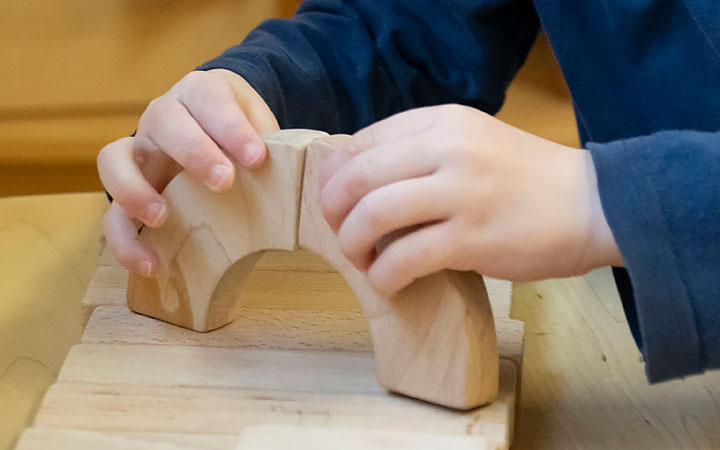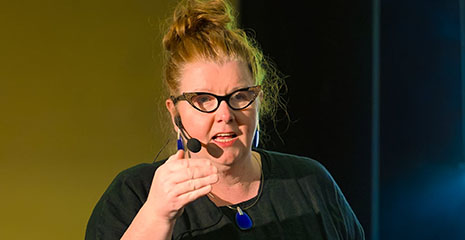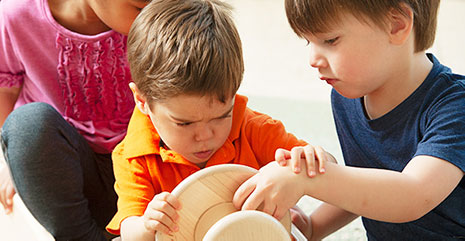What is happening to fine motor development?
| September 2017Note: Kindergarten is the American equivalent of Year 1.
Lacking fine motor skills is not “fine” in kindergarten
A new and disturbing phenomenon is rising on the educational horizon. Many children are arriving at kindergarten lacking the basic fine motor skills needed to hold a pencil and write. This lack of dexterity in their fingers and hands can be attributed to the increased use of touch screen technology and decreased use of crayons, paints, pencils, scissors, clay, and other manipulatives in their daily lives.
Along with social-emotional skills and curiosity, fine motor skills are among the priority readiness skills for kindergarten. If children arrive at school lacking the fine motor control and finger strength necessary to hold a pencil, they will struggle to master other requirements in kindergarten. This is a huge problem because today’s kindergarten demands so much more writing and desk work than ten years ago.
This predicament cannot be remedied over night. Like large motor skills, fine motor skills develop gradually over time with much practice and repetition. Perhaps we are more aware of the more visible and exciting large motor achievements: A child first holds her head up, rolls over, then sits, crawls, pulls to a stand, walks, then runs. Fine motor development starts with grasping objects (mommy’s finger, a rattle, a toy), holding a bottle, picking up food to eat, manipulating a spoon, using hands for purposeful reasons like block building and play dough, buttoning and zippering, using art tools to draw and write, and only then using a pencil or pen to write a name or copy words. While these two progressive developmental sequences are normal in child development, if the sequence is impeded along the way, the child will not develop as she should. We are seeing this with fine motor development in today’s five-year-olds who, from infancy, are spending too much time “swiping and tapping” on screens and not playing with a large range of manipulatives.
Technology is not going away, so it is up to adults to limit its use and ensure that young children have normal childhood play experiences. The American Academy of Pediatrics recommends absolutely no screen time for children under the age of two, and less than an hour a day for preschoolers. Parents should not give their smart phones to babies in their car seats or strollers. They should not play videos for infants and toddlers to keep them occupied. They should not take iPads to restaurants. Preschoolers should not have televisions in their bedrooms.
Advertising often convinces parents that children are learning from the two-dimensional computer games and applications they use. Children, however, live in a three-dimensional world and need to be learning from interactions with real objects or people. For example, the way children learn what “three” means is to hold three objects, eat three grapes, build with three blocks, see how many sets of three are in a little box of raisins, make a triangle with three pretzel sticks. Children learn by doing and experiencing, not by passively watching.
The classic materials of childhood are time-tested to provide practice in fine-motor skills, strengthening all the little hand muscles. Adults should ensure that children have access to these materials both at home and at nursery:
- crayons, markers, chalk, paints, pencils, scissors
- blocks, Lego, other manipulatives
- dolls and stuffed animals for dressing and undressing
- play dough, finger paint, clay, mud
Finger games like Itsy Bitsy Spider and Where is Thumbkin? are also excellent in increasing coordination of the fingers and hands.There are so many wonderful and playful activities that adults can do with children with to help build fine motor skills.
The Gesell Developmental Observation-Revised (GDO-R) assessment evaluates many kindergarten readiness skills. In recent years though, teachers have commented that low scores in fine motor skills pulled down the children’s overall developmental age. Some teachers asked if they could ignore the fine motor section of the assessment. The answer is no! Fine motor skills are a very important part of whole child development and are essential for academic success.
At-home activities for building fine motor skills
Try incorporating these activities into the daily routine with your child:
Kitchen projects: Making home-made play dough strengthens muscles in the hands and fingers. Roll snakes and balls of all sizes; build with the balls and snakes. Your child can play with play dough at the counter or table while you make dinner.
Make peanut butter or sugar cookies that require the dough to be rolled into balls and smashed with a fork. Meatballs are fun and yummy, too.
Playing grocery store: Keep your canned goods on a bottom shelf. Allow your child to play grocery store – take out and rearrange the cans, sort by size, colour, or content. This is a maths readiness skill, too.
Sorting silverware or setting the table: Sorting silverware into its proper holder is a maths skill; as is the patterning your child will do by laying the napkin, knife, fork, and spoon in order at each place-setting.
Eating with chop sticks: This is a more advanced fine motor skill, but not impossible to teach. Children in Asian countries learn quite young. Use chopsticks to pick up cotton balls, round cereal, or other small objects.
Folding clothes: Start with folding washcloths or towels. Fold in half, then fold again to make a quarter.
Stringing things: Make bracelets and necklaces by threading pasta, Fruit Loops, or beads onto pipe cleaners or thick strings. Add a pattern and you add math!
Playing dress-ups: Putting on coats and gloves, zipping up, snapping, buttoning, and tying shoes all help with building fine motor strength. Dressing a doll or stuffed animals is just as good, too!
Practising with scissors: Start with safety scissors and a 10 cm strip of paper to snip, snip, snip with and make fringe. Later, draw a path on the paper to cut along. Make confetti by cutting little snips of various coloured, textured, and shiny wrapping paper. Cut pictures out of magazines and make a collage. Play dough is an excellent soft material for beginners to practice scissor skills on. Roll snakes and cut them into pieces.
Colouring and drawing: Encourage creativity by providing a variety of art mediums. Colour with hard pressure, colour with soft pressure. Outline the object hard, colour soft inside. Instead of colouring, have the child fill the space with little controlled circles – pointillism – a captivating art technique.
Limiting technology: Put away the electronics. Or, better yet, create your own “TV program” by making a story scroll. After drawing out the story, scene by scene, on a long piece of paper, roll the paper tightly onto a cardboard tube. Make a “screen” by cutting a window out of a cardboard box. Mount the scroll inside the box on the left. Stretch the beginning of the story across the screen and tape it to another empty roll mounted on the right side of the box. Turning the right tube to make the scroll move helps develop fine motor skills too.








